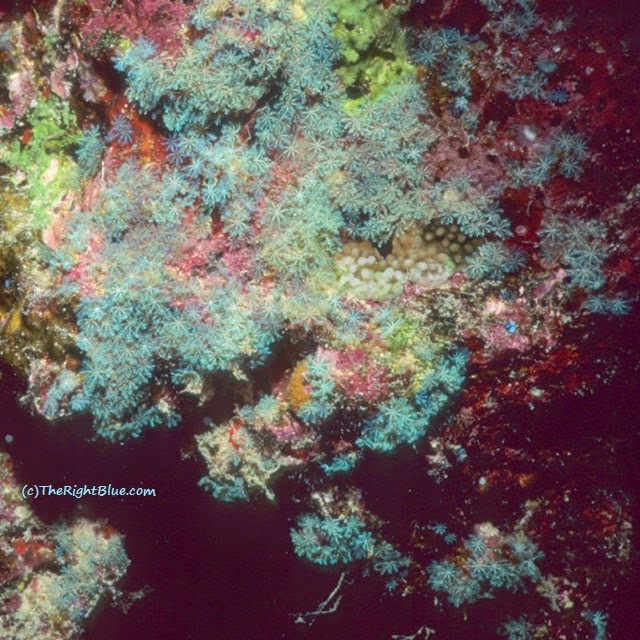 |
| Blue Snowflake Coral (Sarcothelia edmonsoni), a Hawaiian endemic Octocoral |
The underwater landscape in Hawaii is not known for the presence of soft corals. There are hard, stony corals aplenty on Hawaiian reefs, but the sea plumes, colorful Nephtheid soft corals, and sea fans found on most other tropical reefs around the world are largely absent in Hawaii.
The pretty blue Octocoral pictured above is one of relatively few soft coral species that live in Hawaiian waters. Some soft corals in Hawaii are not seen by divers because they grow at depths beyond sport diving range. Others, like this one, are overlooked more often than not.
It is easy for a diver to swim right past a patch of Blue Snowflake coral without noticing it. The species is what we think of as a "low-rise" coral. The colonies form mats on the surfaces of rocks and dead coral. From a distance, the colonies look kind of "mossy." You have to get in close to observe the tiny flower-like polyps, but once you spot those, there is no doubt that you are looking at an Octocoral.
Blue Snowflake Coral is a Hawaiian endemic, i.e., it occurs naturally only in Hawaiian waters. Its scientific name is Sarcothelia edmonsoni, but it was formerly classified as Anthelia edmonsoni. (If you are searching for information about the species, you may have to look up both names). It is a member of the Xeniidae family.
Sarcothelia edmonsoni is the primary food source for another creature endemic to Hawaii, the sea slug Marionia hawaiiensis* (formerly known as Tritonia hawaiiensis). It makes sense -- doesn't it? -- that an endemic critter would have another endemic species as its main prey.
I photographed this example of Sarcothelia edmonsoni along the South Kona coast of Hawaii's Big Island, near the edge of Honaunau Bay.
-------------------------------------------------------------
*I don't have a photo of Marionia hawaiiensis, so click here to see the creature on Cory Pittman and Pauline Fiene's site, Sea Slugs of Hawaii.

BNSullivan.jpg)
BNSullivan465x300.jpg)
BNSullivan.jpg)


BNSullivan.jpg)

No comments:
Post a Comment
We welcome your comments and invite your questions. Dialogue is a good thing!
Bobbie & Jerry